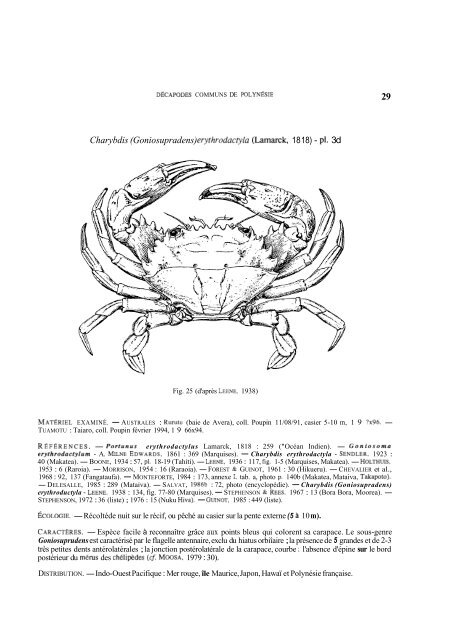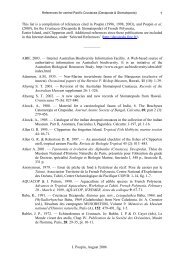Summary and/or pdf article - Database of Crustacea (Decapoda ...
Summary and/or pdf article - Database of Crustacea (Decapoda ...
Summary and/or pdf article - Database of Crustacea (Decapoda ...
You also want an ePaper? Increase the reach of your titles
YUMPU automatically turns print PDFs into web optimized ePapers that Google loves.
DÉCAPODES COMMUNS DE POLYNÉSIE 29<br />
Charybdis (Goniosupradens) erythrodacvla (Lamarck, 18 18) - pl. 3d<br />
Fig. 25 (d'après LEENE, 1938)<br />
MATÉRIEL EXAMINÉ. - AUSTRALES : Rurutu (baie de Avera), coll. Poupin 11/08/91, casier 5-10 m, 1 9 ?x96. -<br />
TUAMOTU : Taiaro, coll. Poupin février 1994, 1 9 66x94.<br />
RÉFÉRENCES. - P<strong>or</strong>tunus erythrodactylus Lamarck, 1818 : 259 ("Océan Indien). - Goniosoma<br />
erythrodactylum - A. MILNE EDWARDS, 1861 : 369 (Marquises). - Charybdis erythrodactyla - SENDLER, 1923 :<br />
40 (Makatea). - BOONE, 1934 : 57, pl. 18-19 (Tahiti). - LEENE, 1936 : 117, fig. 1-5 (Marquises, Makatea). - HOLTHUIS,<br />
1953 : 6 (Raroia). - MORRISON, 1954 : 16 (Raraoia). - FOREST & GUINOT, 1961 : 30 (Hikueru). - CHEVALIER et al.,<br />
1968 : 92, 137 (Fangataufa). - MONTEFORTE, 1984 : 173, annexe 1, tab. a, photo p. 140b (Makatea, Mataiva, Takapoto).<br />
- DELESALLE, 1985 : 289 (Mataiva). - SALVAT, 1986b : 72, photo (encyclopédie). - Charybdis (Goniosupradens)<br />
erythroductyla - LEENE, 1938 : 134, fig. 77-80 (Marquises). - STEPHENSON & REES, 1967 : 13 (B<strong>or</strong>a B<strong>or</strong>a, Mo<strong>or</strong>ea). -<br />
STEPHENSON, 1972 : 36 (liste) ; 1976 : 15 (Nuku Hiva). - GUINOT, 1985 : 449 (liste).<br />
ÉCOLOGIE. -Récolté de nuit sur le récif, ou pêché au casier sur la pente externe (5 à 10 m).<br />
CARACTÈRES. - Espèce facile à reconnaître grâce aux points bleus qui col<strong>or</strong>ent sa carapace. Le sous-genre<br />
Goniosuprudens est caractérisé par le flagelle antennaire, exclu du hiatus <strong>or</strong>biîaire ; la présence de 5 gr<strong>and</strong>es et de 2-3<br />
très petites dents antérolatérales ; la jonction postérolatérale de la carapace, courbe ; l'absence d'épine sur le b<strong>or</strong>d<br />
postérieur du mérus des chélipèdes (cf. MOOSA, 1979 : 30).<br />
DISTRIBUTION. - Indo-Ouest Pacifique : Mer rouge, île Maurice, Japon, Hawaï et Polynésie française.





